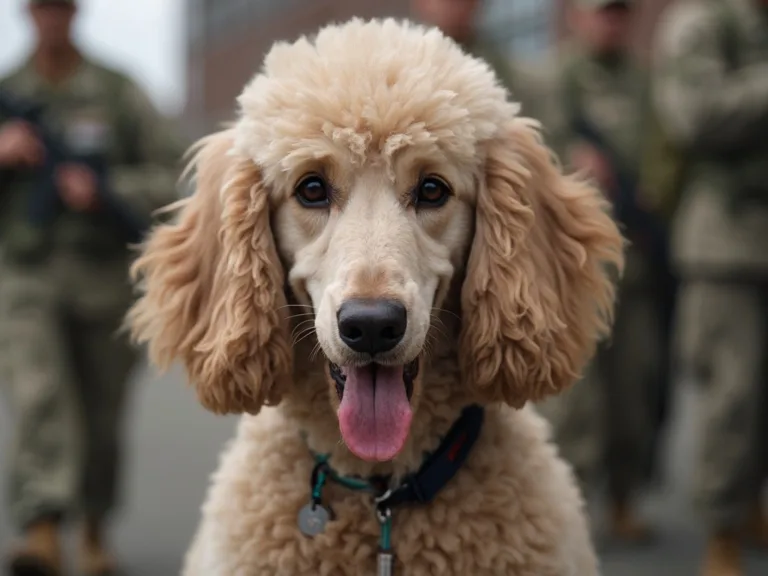Poodle Size Chart: The Differences In Size Within This Breed
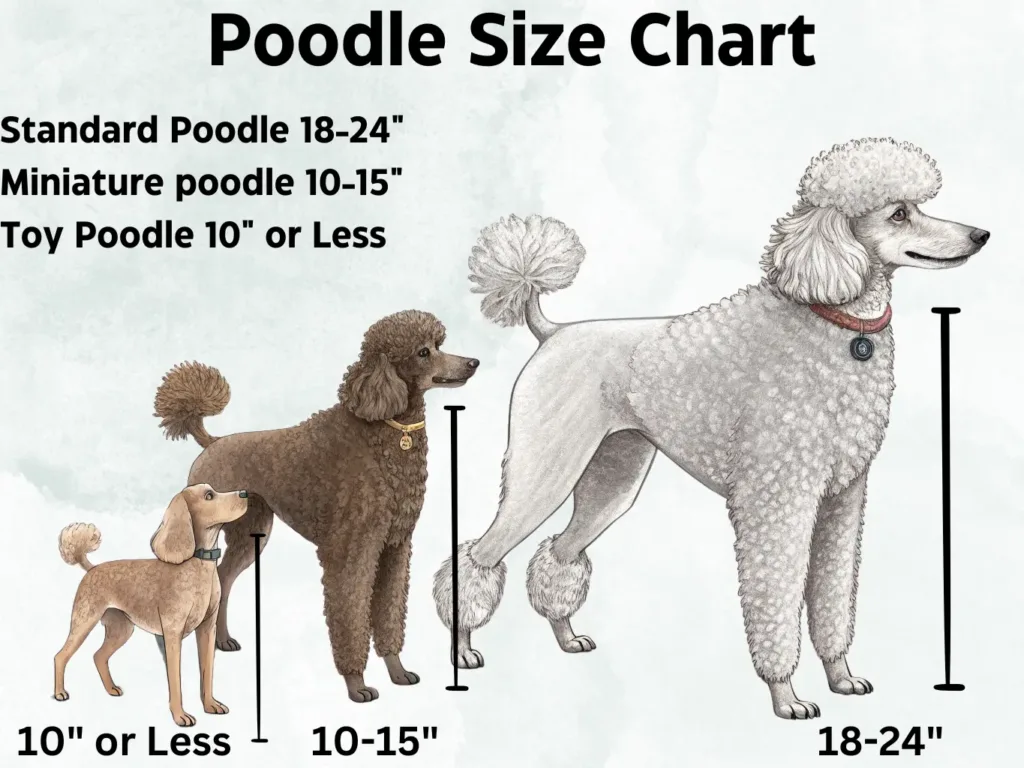
Poodles come in three distinct sizes that can be seen on our poodle size chart: Standard (18-24 inches, 45-70 pounds), Miniature (10-15 inches, 10-20 pounds), and Toy (under 10 inches, 4-10 pounds). If you’re an active family with space, a Standard Poodle‘s athletic build and versatility might suit you.
Apartment dwellers often prefer the adaptable Miniature, while those in tight quarters will love the Toy’s compact size. Each size brings unique traits: hypoallergenic coats, high intelligence, and affectionate personalities.
Your perfect poodle companion depends on your living situation, energy level, and personal preferences. Stick around to uncover more breed insights that’ll help you choose.
Understanding Poodle Breed Size Categories

While Poodles are renowned for their elegance and intelligence, their size variations often surprise potential owners.
When exploring a poodle size chart, you’ll discover three primary size categories recognized by the AKC: Standard, Miniature, and Toy Poodles, each with distinct characteristics that impact poodle growth and health.
Standard Poodles, the largest category, typically stand 18-24 inches tall and weigh 45-70 pounds. These dogs are robust and well-suited for active families, offering strength and versatility.
Miniature Poodles range from 10-15 inches, weighing around 15 pounds, making them perfect for apartment living while maintaining the breed’s signature intelligence.
Toy Poodles represent the smallest official size, standing under 10 inches and weighing 6-8 pounds. Despite their diminutive stature, they possess the same spirited personality as their larger counterparts.
Each poodle size category requires tailored care, with variations in exercise needs, grooming requirements, and potential health considerations.
Understanding these poodle size categories helps you choose a companion that best matches your lifestyle, ensuring a harmonious relationship between you and your furry friend.
Your choice will depend on your living space, activity level, and personal preferences.
Standard Poodle: Largest Variety
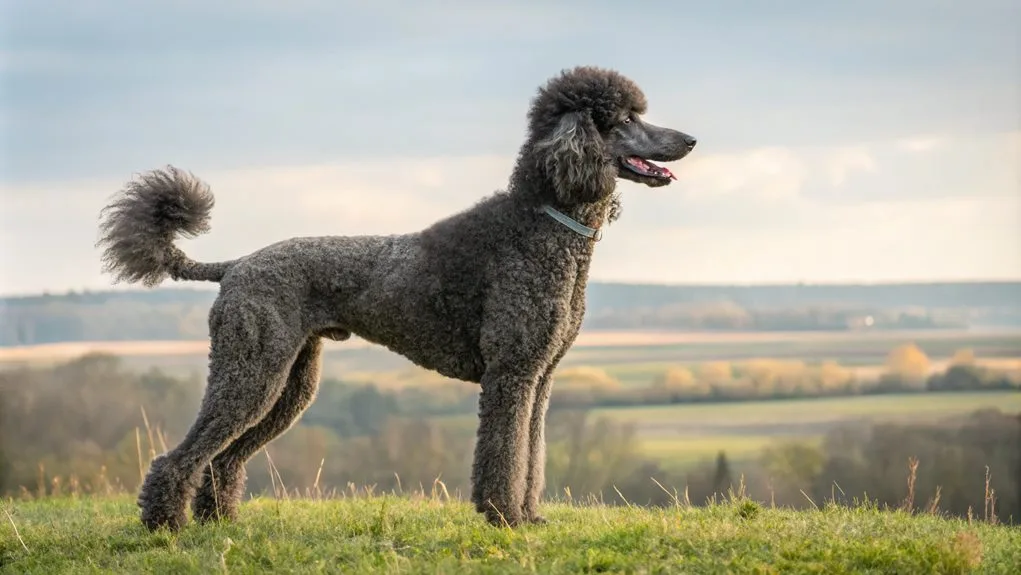
The Standard Poodle stands as the most majestic member of the Poodle family, embodying strength, intelligence, and elegance in one impressive package.
As the largest variety recognized by the AKC, these dogs command attention with their regal stature and remarkable capabilities.
When you’re considering a Standard Poodle, you’ll want to understand their impressive adult size. Typically, males weigh between 60-70 pounds, while females range from 45-60 pounds. Their height usually spans 18-24 inches at the shoulder, making them substantial companions for active families and individuals.
Poodle breeders take great pride in maintaining the breed’s exceptional qualities. The Standard Poodle’s weight range and height reflect their athletic heritage as water retrievers.
Their muscular build and proportionate frame showcase the breed’s functional design, combining strength with grace.
If you’re looking for an intelligent, versatile dog that can adapt to various living situations, the Standard Poodle might be your perfect match. They excel in activities from obedience and agility to simply being devoted family members.
Their hypoallergenic coat and impressive size make them a standout choice for dog enthusiasts seeking a remarkable companion.
Miniature Poodle: Medium-Sized Companion
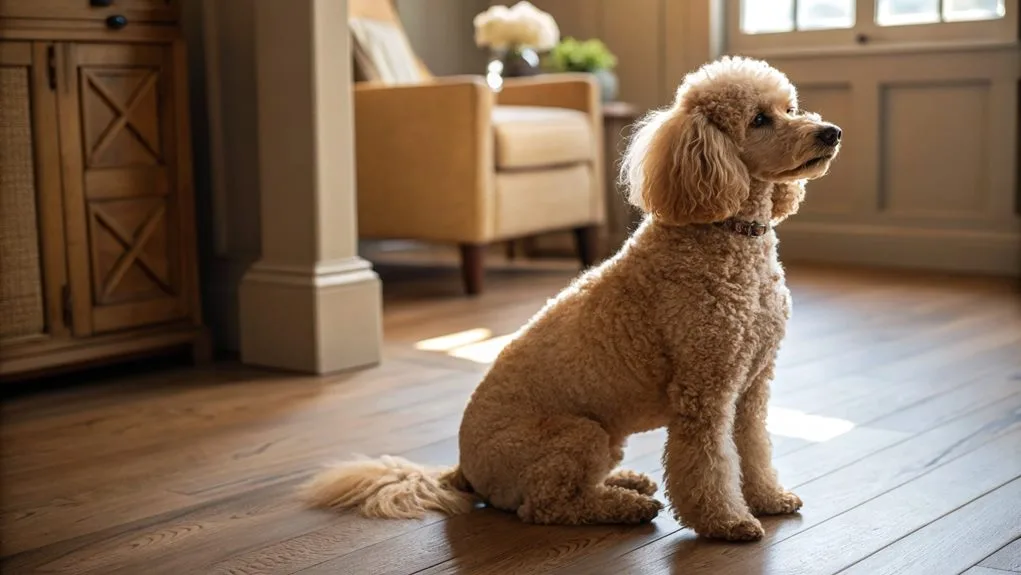
Stepping down from the impressive Standard Poodle, dog lovers will find the Miniature Poodle offers a perfectly compact alternative that doesn’t sacrifice intelligence or personality.
As a medium-sized companion, this delightful breed typically weighs between 10-20 pounds and stands 10-15 inches tall, making them ideal for various living spaces.
Key characteristics of the Miniature Poodle include:
- Remarkable intelligence that rivals larger dog breeds
- Adaptable temperament suitable for apartments and family homes
- High energy levels that demand regular exercise and mental stimulation
Your Miniature Poodle’s exercise needs can be met through daily walks, interactive play sessions, and training activities that engage their sharp mind.
Their personality traits shine through their alertness, playfulness, and strong desire to be close to their human companions. Grooming requirements remain consistent with the Poodle breed, necessitating regular brushing and professional trimming every 4-6 weeks to maintain their distinctive coat.
Despite their smaller size, Miniature Poodles possess a confident and spirited nature. They’re not just lap dogs but active, engaging companions that thrive on interaction and will quickly become an integral part of your family dynamic.
Toy Poodle: Small and Adorable

Adorable bundles of energy describe the Toy Poodle, a pint-sized companion that packs remarkable personality into a tiny frame. You’ll find these smallest poodles typically weighing between 4-10 pounds, with an average size under 10 inches tall, making them perfect for apartment living and travel.
When considering a Toy Poodle puppy size, you’ll notice they’re even more compact than miniature poodles. These diminutive dogs boast hypoallergenic coats that shed minimally, which makes them ideal for allergy sufferers. Their teacup variants can be even smaller, though not officially recognized by major kennel clubs.
You’ll appreciate their intelligent and affectionate nature. Despite their small stature, Toy Poodles possess big personalities and remarkable trainability. They’re adaptable companions who thrive on human interaction and excel in various activities from lap-sitting to agility competitions.
Their size doesn’t compromise their spirit; these tiny dogs are alert, playful, and surprisingly robust. They require regular grooming to maintain their signature curly coat and benefit from moderate exercise to keep them healthy and mentally stimulated.
Choose a Toy Poodle if you want a small, loving companion with tremendous character packed into a petite package.
Comparing Growth and Weight Ranges
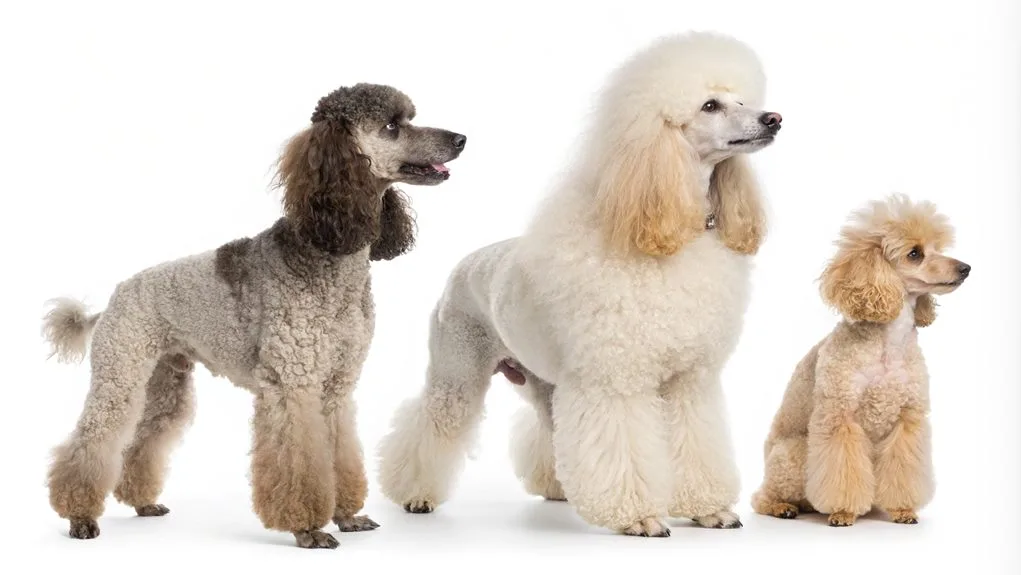
Poodle growth charts reveal fascinating variations across different sizes, reflecting the breed’s remarkable genetic diversity.
When comparing standard poodles, miniature poodles, and toy poodles, you’ll notice significant differences in their growth trajectories and weight ranges that can help you understand each poodle size’s unique development pattern.
Key comparisons across poodle sizes include:
- Standard poodles typically reach full height of 18-24 inches and weigh 45-70 pounds by two years.
- Miniature poodles mature faster, often achieving their adult size around 12 months, weighing 10-15 pounds.
- Toy poodles remain the smallest, with most reaching their full height under 10 inches and weighing just 4-8 pounds.
Understanding these growth charts becomes essential when selecting a poodle that matches your lifestyle and living space.
While standard poodles offer more substantial companionship, miniature and toy poodles provide compact alternatives with equally vibrant personalities.
Each poodle size follows a distinct growth pattern, influenced by genetics, nutrition, and overall health.
Your choice depends on understanding these nuanced weight ranges and growth expectations, ensuring you select a poodle size that perfectly complements your home and activity level.
Selecting the Right Poodle From The Poodle Size Chart
Choosing the right poodle size requires careful consideration of your lifestyle, living space, and personal preferences. Each poodle size offers unique characteristics that’ll match different living situations, so you’ll want to evaluate your specific needs carefully.
Standard poodles work best for active families with spacious homes. They’re larger, more robust, and typically excel with children and outdoor activities. These dogs need more exercise and grooming commitment but provide substantial companionship.
Miniature poodles offer a balanced option for apartment dwellers or smaller households. They’re energetic, adaptable, and require moderate exercise. Their personality traits combine intelligence with playfulness, making them excellent companions for singles or couples.
Toy poodles suit those with limited space and minimal exercise capabilities. They’re perfect lap dogs, traveling companions, and ideal for urban living. Their compact size means less demanding grooming requirements and easier maintenance.
When choosing poodle sizes, consider not just physical space but also your daily routine, activity level, and willingness to invest in grooming and training.
Each poodle variety has distinct personality traits, so match the dog’s characteristics with your lifestyle for the most harmonious relationship.
Health and Maintenance Considerations For This Dog Breed

How can you guarantee your poodle stays healthy and thriving throughout its life? Maintaining your poodle’s health requires a proactive and thorough approach tailored to their specific size and genetic predispositions.
You’ll need to prioritize several key aspects of care to make sure your furry companion remains in peak condition.
Consider these vital health maintenance strategies:
- Conduct regular health screenings to identify potential genetic issues early
- Provide a balanced diet specific to your poodle’s size and age requirements
- Schedule professional grooming and at-home weight checks to monitor overall wellness
Your poodle’s exercise needs vary by size, but consistent physical activity is essential for maintaining muscle tone and preventing obesity.
Standard Poodles typically require more rigorous exercise compared to Toy Poodles, who need gentler, shorter activity sessions.
Regular grooming isn’t just about appearance; it’s an important health practice that allows you to detect skin issues, lumps, or potential health concerns early.
Professional veterinary consultations should occur annually, with tailored screenings based on your poodle’s specific size and potential genetic risks.
Conclusion
You’ve explored the diverse world of Poodle sizes, discovering there’s a perfect match for every lifestyle. Whether you’re drawn to the majestic Standard or the adorable Toy, you’ll find a loyal, intelligent companion. Remember that each size brings unique characteristics, so consider your living space, activity level, and personal preferences when making your choice.
FAQ: Poodle Size Chart
The poodle breed is categorized into three main sizes: Tiny Toy, Miniature, and Standard. Each type of poodle has its own specific breed standard and expected height and weight. Toy Poodles are usually finished growing at a height of up to 10 inches, Miniature Poodles are usually 10 to 15 inches tall, and Standard Poodles are usually more than 15 inches tall, but typically 18 to 24 inches. The size of poodles is a critical factor in determining their care and training needs.
While the size of poodles can influence certain traits, poodle owners often find that temperament is more closely related to the individual dog’s upbringing and socialization. However, larger poodles are usually considered to be more laid-back and calm, whereas smaller poodles are usually more energetic and lively. Regardless of size, all poodles don’t respond well to harsh treatment and require gentle training techniques.
Each type of poodle size can have its own health concerns. Smaller poodles are usually prone to dental issues and patellar luxation, while larger poodles are usually susceptible to hip dysplasia and Addison’s disease. Regular veterinary check-ups and a balanced diet can help mitigate these risks. It is essential for poodle owners to consult with your veterinarian to tailor a healthcare plan suited to their poodle’s specific needs.
The size of poodles significantly impacts their exercise requirements. Standard poodles are usually more energetic and require more physical activity, including long walks and playtime in a spacious environment. Miniature and Tiny Toy poodles are usually satisfied with shorter walks and indoor play. Regardless of size, all poodles don’t thrive when under-exercised.
Sources: American Kennel Club





